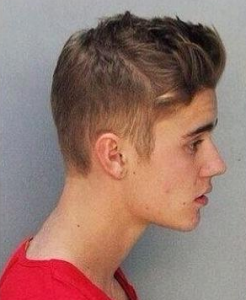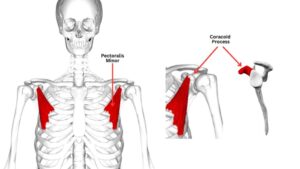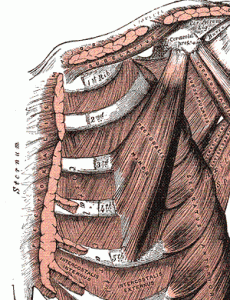 Chronic neck pain occurs for many reasons. In the last week or two writing about forward head posture and the cervical spine, I have covered a number of the issues that can lead to chronic neck pain.
Chronic neck pain occurs for many reasons. In the last week or two writing about forward head posture and the cervical spine, I have covered a number of the issues that can lead to chronic neck pain.
Today we look at pectoralis minor, a muscle always in the mix when it comes to poor posture and pain.
Pectoralis minor is a small muscle in the front of the body attaching from the coracoid process of the shoulder blade and then to the 3rd, 4th, and 5th rib.

Its function is to pull the shoulder blade forward and down though it can also elevate the rib cage in certain actions.
Chronic neck pain that results from round-shouldered posture is likely to involve short and tight pectoralis minor muscles pulling the shoulder blade too far forward and down. There are a lot of other types of pain that can be associated with this muscle as well.
Dysfunction in the pectoralis minor can cause local pain at the site of the muscle.
It can also be connected to pain between the shoulder blades most often in the rhomboid muscles.
Tight pectoralis muscles can also impinge on nerves creating pain, tingling, or numbness running down to the forearm, wrist, and hand.
Chronic neck pain due to forward head posture involves the cervical spine moving past the natural support that comes with a well-aligned spine.
As the head moves forward it becomes heavier and takes other parts of the skeleton with it.
As a result muscles at the front of the body need to begin holding up the head.
It might be subtle but you should be able to feel the pectoralis minor shorten as your head moves forward.
Place your hand in the area of pectoralis minor and move your head and neck forward and back. Moving the head forward will ultimately take the head of the arm bones and even shoulder blades with it.
As this happens pectoralis minor shortens.
In the yoga practice a tight pectoralis minor rears its head most often in the transition from plank to chaturanga. I am constantly teaching about the need to keep the head of the arm bones back in this transition.
When pectoralis minor is tight the shoulder blade comes forward and down way too much as the muscles of the back, most specifically the lower trapezius muscles, fail to engage in opposition to keep the shoulder blades on the back.
There is always chicken and egg stuff in play in these discussions.
Does the head moving forward shorten the pectoralis minor, or does the short pectoralis minor pull the head forward?
It is likely a mix of both, and both the head coming forward and short tight pectoral muscles can lead to chronic neck pain.
***


